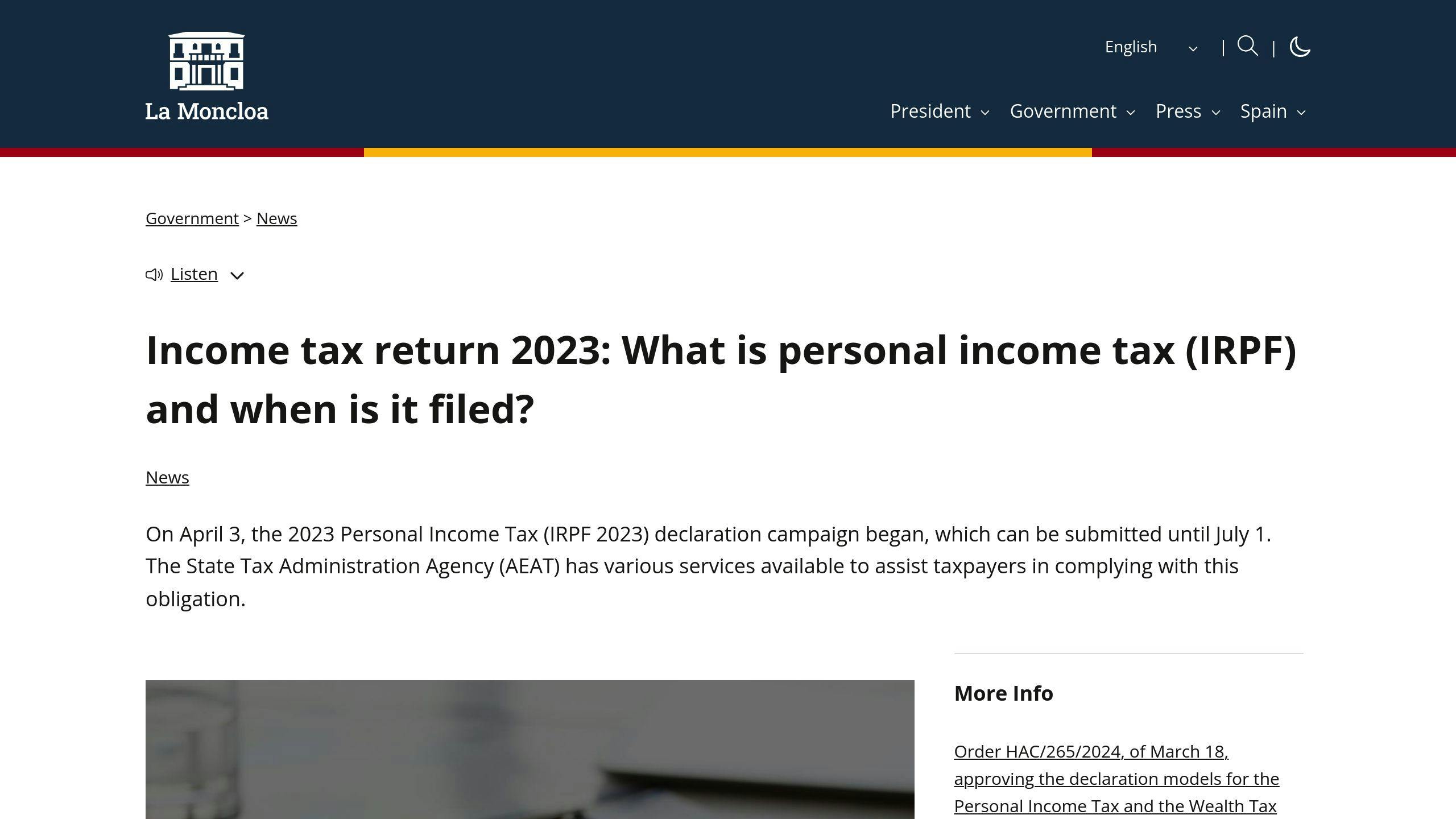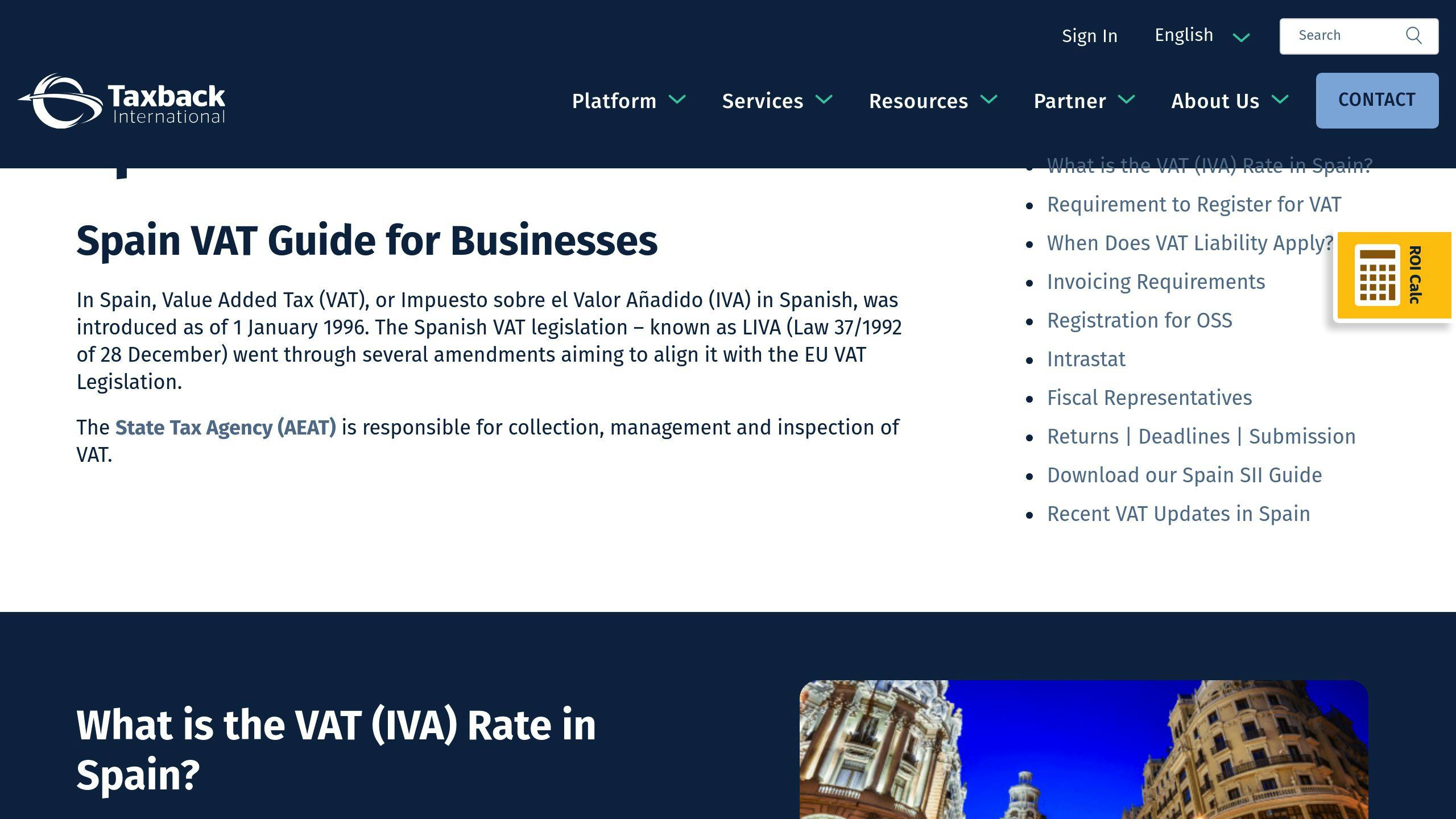Spain's Autonomo system is crucial for freelancers working in the country. Here's what you need to know:
- It's a legal framework for self-employed individuals
- Provides social security benefits and healthcare coverage
- Requires monthly payments based on income
- Involves complex tax obligations
Key points:
- Registration process includes getting a NIE, registering for taxes, and joining social security
- Monthly payments start at €230 for those earning under €670
- New freelancers get discounts for up to 18 months
- Taxes include income tax (IRPF) and value-added tax (IVA)
- Offers benefits like healthcare, unemployment, and maternity/paternity leave
Quick Comparison:
| Aspect | Old System | New System (2023) |
|---|---|---|
| Payment Structure | Flat fee | Income-based |
| Minimum Payment | €294 | €230 |
| Flexibility | Limited | Can change contribution level 6 times/year |
| New Freelancer Discount | Flat rate | Tiered structure (€60 - €200.30) |
The Autonomo system offers freedom but comes with responsibilities. It's essential to understand the registration process, payment structure, and tax obligations to succeed as a freelancer in Spain.
Related video from YouTube
What is the Autonomo System?
The Autonomo system is Spain's way of handling self-employed workers. It's how freelancers and independent contractors operate legally in the country.
Here's what you need to know:
- It's for people who work for themselves, not for a company
- You're in charge of your own taxes and social security
- You can work for multiple clients or just one
To become an autónomo, you'll need:
- A work permit (if you're not from the EU)
- A Spanish bank account
- An NIE (foreign identity number)
- A social security number
- Registration in the right tax group
There are two main types of autónomos:
1. Autónomo societarios: These are people running businesses
2. Autónomo persona física: These are freelancers or sole traders
The system has its perks:
- You get health insurance
- There's protection if you have an accident
- You can take maternity or paternity leave
But it's not all smooth sailing:
- You have to create your own invoices
- Keeping clear records is a MUST
- You're responsible for filing your taxes
And heads up: medical wait times can be long. That's why many freelancers end up getting private health insurance.
| Task | What You Need to Do |
|---|---|
| Tax Registration | Fill out Form 036 or 037 with the tax office |
| Social Security | Submit Form TA0521 to join RETA |
| Business Type | Pick an IAE code that matches what you do |
Bottom line: The Autonomo system gives you freedom, but it comes with responsibilities. Make sure you're ready for both before diving in.
How to Register as an Autonomo
Want to become self-employed in Spain? Here's what you need to know:
Who Can Apply?
Anyone over 16 can register, but the process differs:
- EU/EEA/Swiss citizens: It's straightforward.
- Non-EU citizens: You'll need a visa, residence permit, and work permit.
Registration Steps
1. Get a Work Permit (Non-EU Only)
Before coming to Spain:
- Apply for a self-employment visa at your local Spanish embassy
- Fill out form EX-07
- Bring your passport, business plan, proof of funds, clean record, and health insurance
- Pay the fee (about €80)
2. Get Your NIE
This number is crucial. Here's how:
- Fill out form EX-15
- Bring your passport or ID
- Explain why you need it
- Apply at a police station or immigration office
3. Register for Taxes
Head to your local Tax Agency:
- Complete Model 036 or 037
- Bring your NIE, passport, and Spanish bank details
4. Join Social Security
Within 30 days of tax registration:
- Visit a Seguridad Social office
- Fill out form TA_0521
- Prove your identity and address
| Step | Form | Where to Go |
|---|---|---|
| Work Permit | EX-07 | Spanish embassy |
| NIE | EX-15 | Police/immigration |
| Taxes | 036/037 | Tax Agency |
| Social Security | TA_0521 | Seguridad Social |
It's a bit of a process, but being prepared helps. Need help? Find My Lawyer can connect you with experts in Spanish immigration and business law.
Social Security Payments
Spain's Autónomo system got a major overhaul in 2023. Out with the old flat-rate payments, in with a new income-based system. The goal? Fairer contributions for the self-employed.
How It Works Now
Your monthly income determines your social security payment. Here's the breakdown:
| Monthly Income | 2023 Monthly Payment |
|---|---|
| Under €670 | €230 |
| €2030 - €2330 | €320 |
| Over €6,000 | €590 (expected in 2025) |
Simply put: earn less, pay less. Earn more, contribute more.
Rolling with the Punches
Business ups and downs? No problem. You can:
- Switch your contribution level up to 6 times a year
- Base payments on your average income from the last 12 months
New to the Game?
Just starting as an autónomo? You might catch a break:
- Pay just €80/month for your first year
- In Madrid or Andalusia? You might pay NOTHING for year one
Want to keep that sweet deal for another year? You'll need to:
1. Ask for an extension before year two kicks off
2. Keep your annual net income below the minimum wage (€15,876 in 2024)
Stay on Top of Your Payments
1. Crunch the numbers: estimate your income and expenses early
2. Get expert advice: talk to an accountant or gestor about your best contribution level
3. Go digital: use the Importass portal to manage your payments online
Taxes for Autonomos
Being an autonomo in Spain means dealing with taxes. Here's what you need to know:
Income Tax (IRPF)

The more you earn, the more you pay. Here's a quick breakdown:
| Income Range | Tax Rate |
|---|---|
| €0 - €12,450 | 19% |
| €12,451 - €20,200 | 24% |
| €20,201 - €35,200 | 30% |
| €35,201 - €60,000 | 37% |
| €60,001 - €300,000 | 45% |
| Over €300,000 | 47% |
You'll file quarterly forms to keep the tax folks in the loop. Most clients will hold back some of your invoice for taxes.
Value Added Tax (IVA)

You'll charge VAT (IVA) on your invoices. It's usually 21%, but can be 10% or 4% for some services. You'll report this quarterly on Form 303.
For example: €100 service + €21 VAT = €121 total invoice.
Deductible Expenses
You can write off business expenses like:
- Office supplies
- Work-related courses
- Travel for work
- Part of your home office costs
Keep those receipts! You can also deduct 5% of your net income (up to €2,000) for hard-to-prove expenses.
Annual Tax Return
Every year between April and June, you'll file your declaración de la renta. This settles any over or underpayments from the year.
Tax Management Tips
1. Track everything: Use a spreadsheet or software for all income and expenses.
2. Save for taxes: Set aside part of each payment for tax time.
3. Get help: A gestor or accountant can navigate the tricky Spanish tax system.
4. Watch the calendar: Mark those tax deadlines to avoid penalties.
Perks of Being an Autonomo
Being an autonomo in Spain has some sweet perks. Let's break 'em down:
Healthcare Coverage
As an autonomo, you get the same healthcare as regular employees. That means:
- You can hit up medical centers and hospitals
- You're covered for preventive care and vaccinations
- Emergency care? Yep, that too
- You'll save on prescriptions
And here's the kicker: your family gets covered too. Kids, non-working partner - they're all in.
Social Security Benefits
Your social security contributions aren't just money down the drain. They've got your back:
| Benefit | What You Get |
|---|---|
| Maternity/Paternity Leave | 16 weeks off, full pay |
| Sick Leave | 75% pay for common illnesses or injuries |
| Permanent Disability | Full pay or a big one-time payout |
| Unemployment | Up to 2 years of benefits (70% of your average pay) |
Just remember: to get unemployment benefits, you need to be registered and paid up for at least a year.
Retirement Options
Your pension as an autonomo? It's based on what you've been paying in:
- You can retire at 67 (or 65 if you've been contributing for 38.5 years)
- Your pension is calculated at 0.195% of your contribution base per month worked
- You need to contribute for at least 15 years
- Max contribution period is 37 years
Want to retire early? You might be able to stop working up to two years before the legal retirement age if you meet certain conditions.
Tax Deductions
Here's where it gets good. You can write off a bunch of stuff:
- Office supplies
- Work-related courses
- Work travel
- Part of your home office costs
Plus, you can deduct 5% of your net income (up to €2,000) for those hard-to-prove expenses.
Professional Development
Spain's got your back when it comes to leveling up your skills. Keep an eye out for workshops, training, and networking events in your area. They're great for growing your business and meeting other autonomos.
sbb-itb-c1c0fc4
Common Problems and Things to Think About
Being an autonomo in Spain isn't always a walk in the park. Here are some key challenges:
High Social Security Costs
The social security payments can hit hard. In 2023, you're looking at a minimum of €234.30 per month, no matter how much you earn. Ouch.
| Income Level | Monthly Social Security Payment |
|---|---|
| < €670 | €230 |
| €670 - €1,300 | €200 - €294 |
| > €1,300 | Up to €590 |
Complex Tax System
Taxes? They're a headache. You've got quarterly returns and an annual declaration. Many autonomos end up hiring an accountant, which isn't cheap.
Work-Life Balance
It's easy to work 24/7 when you're your own boss. Finding that sweet spot between work and life can be tough.
"Spain isn't self-employed friendly. The state doesn't like autonomos." - Anonymous freelancer
Inconsistent Income
One month you're rolling in it, the next you're scraping by. This rollercoaster makes budgeting a real challenge.
Extra Insurance and Pension Plans
The state pension? Often not enough. Many autonomos find themselves needing private pension plans and extra health insurance.
Smart moves for autonomos:
- Stash away 3-6 months of expenses for rainy days
- Get a gestor to tackle taxes and paperwork
- Draw a line between work and personal time
- Spread your client base to steady your income
- Check out private pension and insurance options
Different Types of Autonomos
Spain's self-employment system isn't one-size-fits-all. Here's a breakdown of the main types:
- Self-Employed Workers (Autónomos)
These are your typical freelancers. They run small businesses or offer services directly to clients.
- Think taxi drivers, hairdressers, artists
- Taxed by modules
- Handle their own workload and invoicing
- Freelance Professionals
Doctors, lawyers, and other specialized service providers fall here.
- Can opt for professional mutuals instead of the Special Regime for Self-Employed Workers
- Often need to join professional associations
- Self-Employed Entrepreneurs (Autónomo Societario)
The big fish - company administrators and corporate self-employed individuals.
- Can't register as employed workers
- Often incorporate as a corporate entity
- Have limited liability
- Economically Dependent Self-Employed Workers (TRADE)
These autonomos rely heavily on a single client.
- At least 75% of income from one client
- Get specific protections
- Example: A computer scientist with a maintenance contract for a hotel
- Agrarian Self-Employed
For those working the land or with livestock.
- Must own agricultural or livestock operations
- At least half of income from these activities
- Covered under SETA (Special System for Agrarian Workers)
- Other Self-Employed
This catch-all category includes self-employed collaborators, worker members of cooperatives, and partners in irregular civil companies.
| Type | Key Feature | Example |
|---|---|---|
| Self-Employed Workers | Run small businesses | Maria, a hairdresser |
| Freelance Professionals | Specialized services | Clarissa, an expat lawyer |
| Self-Employed Entrepreneurs | Corporate self-employed | Lucy, owner of a marketing agency |
| TRADE | 75%+ income from one client | Carlos, a software developer for a tech company |
| Agrarian Self-Employed | Agricultural focus | Ana, an organic olive farm owner |
Each type has its own rules, benefits, and challenges. Your work, clients, and business structure will determine which category fits you best. It's not just about picking a label - it's about finding the right fit for your situation in Spain.
Money Management for Autonomos
As an autonomo in Spain, you need to be smart with your money. Here's how:
Set Up a Business Account
Keep your work and personal money separate. It makes taxes easier.
Some good options:
"Sabadell Self-Employed Account: No fees, free business cards. N26 Business Account: 5% back on monthly autónomo social security (up to €180/year)."
Track Everything
Record all money in and out. Use software to make invoices, track expenses, and create reports.
Save for Taxes
Put aside money for taxes every quarter. A simple way:
| For | Use |
|---|---|
| 70% | Business costs and your pay |
| 30% | Taxes and social security |
Handle Cash Flow
Income can be up and down. Stay on top of it:
1. Check your accounts weekly. Look at payments, bills, and credit card charges.
2. Plan for future costs to avoid surprises.
3. Match automatic payments with when you get paid.
Get All Your Deductions
Keep every receipt. You can deduct:
| What | How Much |
|---|---|
| Home office utilities | 30% of work use |
| Client meals | 100% (with proof) |
| Social security | 100% |
Sam, a video editor, saved over €1,000 in taxes by deducting expenses.
Use Tech Tools
Make life easier with:
- Online invoicing
- Cloud storage for receipts
- Cash flow apps
Legal Matters for Autonomos
As an autonomo in Spain, you need to know some key legal stuff. Let's break it down:
Contracts
You NEED a solid contract. Here's what to include:
- What you're doing
- When it's due
- How you'll get paid
- Who owns the work
- Keeping things hush-hush
- How to end things
"A good freelance contract keeps everyone happy and out of trouble." - Knowmad Lawyer
Insurance
Don't skip on insurance. Here's the deal:
- If you work where people can walk in, you need civil liability insurance
- It covers you if you mess something up
- No insurance? You could be out €190,000 in the worst case
Think about it: An electrician HAS to have this insurance to work legally.
Health Insurance
Private health insurance can be smart:
| What You Get | The Details |
|---|---|
| Tax break | Up to €500 off for your policy |
| Family covered | Up to €4,500 deductible |
| Pay-as-you-go | Different plans to choose from |
Protecting Your Work
Own your stuff. Make sure your contracts say who owns what you create.
Keep Your Papers
Hang onto these for 5 years:
- Invoices you send
- List of your stuff
- Receipts for what you buy
Legal Help
Spanish law can be tricky. Find My Lawyer can hook you up with lawyers who know how to help international freelancers in Spain.
Find My Lawyer: Help for Expats

Struggling with legal issues as an autonomo in Spain? Find My Lawyer's got your back. This online platform connects expats with Spanish lawyers and accountants who get your needs.
Here's what you get:
- Expert directory
- Location and specialty search
- Client reviews
- Secure messaging
- Paperwork help
It's a game-changer for autonomos dealing with contracts, taxes, or immigration. No more hunting for English-speaking lawyers who understand expat life.
How Find My Lawyer helps autonomos:
| Need | Solution |
|---|---|
| Business Setup | Lawyers for autonomo registration |
| Taxes | Accountants for expat tax situations |
| Contracts | Legal review of freelance agreements |
| Visas | Immigration specialists for permits |
| Disputes | Lawyers for client/supplier conflicts |
Just remember: Find My Lawyer is a tool, not a replacement for professional advice. Always talk directly to a qualified lawyer or accountant about your situation.
Wrap-up
The Autonomo system in Spain is a quick way for freelancers to start working for themselves. But it's not all smooth sailing.
Here's what you need to know:
- Signing up is easy, but plan ahead
- You'll pay at least €234.30 a month for social security
- New freelancers get discounts for up to 18 months
- Taxes and paperwork can be a headache
Spain's changing things up. In 2023, they introduced a new payment system based on how much you earn. Here's how it looks for 2024:
| Monthly Net Income | 2024 Quota | Change from 2022 |
|---|---|---|
| Up to €670 | €230 | -€64 |
| €670 to €900 | €255 | -€34 |
| €900 to €1,166.70 | €273 | -€19 |
| €1,166.70 to €1,300 | €297 | -€3 |
| €1,300 to €1,700 | €300 | €0 |
| €1,700 to €2,030 | €332 | +€21 |
| €2,030 to €3,190 | €368 | +€56 |
| More than €6,000 | €542 | +€122 |
Want to make it work? Here's how:
- Save up for fees and surprises
- Think about private health insurance
- Look into private pensions
- Get legal help for contracts
- Don't forget to take breaks
The Autonomo system can be tricky. If you need help, check out platforms like Find My Lawyer. They can connect you with experts who know the ins and outs of being an expat in Spain.
FAQs
Can I move to Spain and be self-employed?
Yes, you can. Here's what you need to do:
- Apply for a Self-Employment work and residence permit
- Submit your application within 60 days of your non-lucrative visa expiring
- If you've renewed your non-lucrative residence permit, apply anytime
How do I register as autónomo in Spain?
To become an autónomo, follow these steps:
- Get a NIE number
- Register with the Spanish Tax Agency
- Sign up with Social Security
- Open a Spanish bank account
Can you be autónomo and employed in Spain?
Yes, you can. This is called "pluriactividad." It might even help you save on social security payments.
How much is autónomo Spain per month?
Your monthly autónomo payment depends on your income. Here's a breakdown for 2024:
| Monthly Net Income | 2024 Quota |
|---|---|
| Up to €670 | €230 |
| €670 to €900 | €255 |
| €900 to €1,166.70 | €273 |
| €1,166.70 to €1,300 | €297 |
| €1,300 to €1,700 | €300 |
| €1,700 to €2,030 | €332 |
| €2,030 to €3,190 | €368 |
| More than €6,000 | €542 |
How much tax does a freelancer pay in Spain?
Freelancers in Spain pay two main taxes:
- Personal Income Tax: Starts at 19% for the first €12,450 earned. Rates increase for higher incomes.
- Value Added Tax (IVA): 21% on most services, regardless of annual turnover. Some services (like education and certain types of writing) might be exempt.
